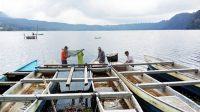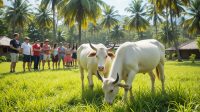- SANGEH Monkey Forest offers a unique blend of natural beauty, cultural significance, and enchanting wildlife encounters. Visitors to this mystical forest can expect to be captivated by the ancient nutmeg trees, intrigued by the playful macaque monkeys, and immersed in the spiritual essence that permeates the surroundings. As ecotourism and conservation efforts continue to evolve, the Sangeh Monkey Forest stands as a testament to the harmonious coexistence of humanity and nature.
Nestled within the lush landscapes of Sangeh Village, Badung, Bali, lies a captivating haven of biodiversity and cultural significance known as the Sangeh Monkey Forest. This forest, located in the village of Sangeh just a short drive or approximately 18 km from Ubud and 40 km from Nusa Dua, offers an immersive experience that combines natural beauty, spiritual ambiance, and the playful antics of its resident macaque monkeys.
A Natural Oasis of Biodiversity
The Sangeh Monkey Forest spans approximately 10 hectares and is characterized by towering nutmeg trees (Palaquium obovatum) that have flourished for centuries. These ancient trees, some of which are over 40 meters tall, create a dense canopy that not only offers a cool and shady environment but also provides a sanctuary for countless flora and fauna species. The forest floor is blanketed by a carpet of fallen leaves, creating a serene and peaceful atmosphere that invites visitors to unwind and connect with nature.
Aside from the nutmeg trees, another key highlight of the Sangeh Monkey Forest is its resident macaque monkeys. Known locally as “kera,” these monkeys are considered sacred and are believed to be the protectors of the forest. The monkeys are friendly and accustomed to human presence, often approaching visitors in search of food. However, it’s important to exercise caution and follow the guidelines provided by the forest management to ensure a safe and respectful interaction.
The Sangeh Monkey Forest holds a special place in Balinese culture and spirituality. The forest is often visited by locals for various religious ceremonies and rituals. The Pura Bukit Sari temple, located within the forest grounds, is a significant place of worship and a testament to the harmonious relationship between nature and spirituality in Bali. The intertwining of cultural practices and natural beauty makes the Sangeh Monkey Forest a truly unique destination.
Conservation Efforts and Ecotourism
In recent years, the Sangeh Monkey Forest has gained popularity among tourists seeking an authentic and immersive natural experience. With increased foot traffic, responsible ecotourism practices have become essential to ensure the preservation of this delicate ecosystem. Efforts are being made by local authorities and conservation organizations to educate visitors about the importance of respecting the environment and wildlife, as well as the significance of the forest in Balinese culture.
Tips for Visitors
Respect Wildlife: While the monkeys may appear friendly, it’s important to maintain a respectful distance and avoid feeding them, as human food can be harmful to their health. Follow the instruction of local guides.
Dress Appropriately: Since the forest is a sacred site, it’s advisable to dress modestly out of respect for the local culture.
Follow Guidelines: Pay attention to the guidelines provided by the forest management to ensure a safe and enjoyable visit for both visitors and wildlife.
Guided Tours: Consider joining a guided tour led by knowledgeable locals who can provide insights into the forest’s history, biodiversity, and cultural significance.
Capture Memories Responsibly: If you plan to take photographs, be mindful of your surroundings and avoid disturbing the wildlife or other visitors.










